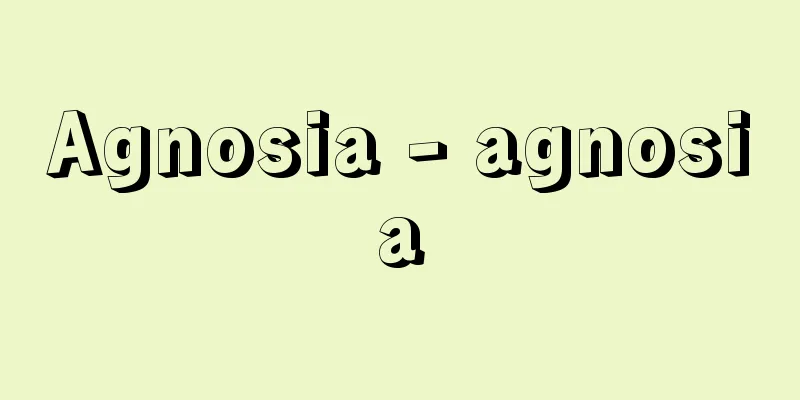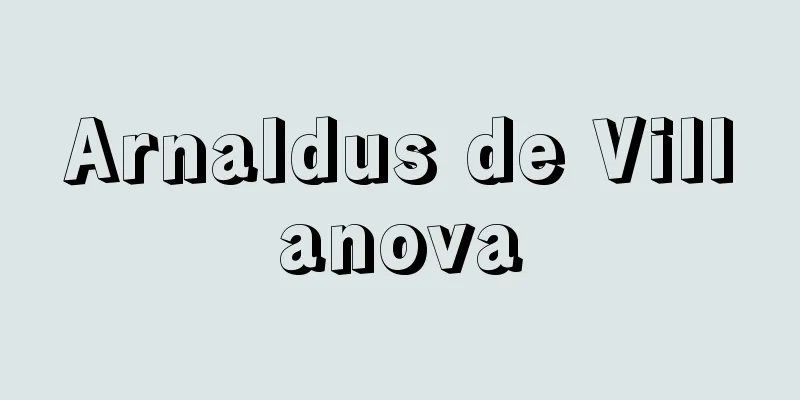Agnosia - agnosia

|
It refers to a state in which an object cannot be recognized only through a certain sense. However, this is premised on the assumption that it is not due to a basic functional disorder of that sense, a disturbance of consciousness, or a generalized cognitive decline. For example, in visual agnosia, basic visual function is preserved, but an object cannot be recognized only through vision. In other words, an individual cannot recognize an object by looking at its shape, but can immediately recognize it by touching it with their hands or hearing its characteristic sound. There are several known types of agnosia: visual agnosia, auditory agnosia, and tactile agnosia. These agnosias are often noticed by the inability to name the objects seen, heard, and touched, respectively. There have also been reports of multimodal agnosia, in which impairments in multiple senses are seen. In addition, the terms somatognosia and anognosia are also used, although they do not fit the definition of agnosia mentioned above. [Visual agnosia] The core symptom of visual agnosia is the inability to identify objects from their shape. Even with visual stimuli, it is possible to identify objects from their characteristic movements. Classically, visual agnosia was divided into two categories, apperceptive visual agnosia and associative visual agnosia, depending on the level of function impaired. In recent years, however, visual agnosia has been divided into three categories, with the addition of integrative visual agnosia, which is intermediate between the two. In perceptive visual agnosia, the recognition of the shape of an object is insufficient, and the object cannot be imitated. In integrative visual agnosia, the object can be partially recognized, but it is difficult to grasp the object's shape as a whole, and it takes a very long time to imitate it. In associative visual agnosia, the shape is recognized well, but it cannot be linked to meaning, and imitations are quick and accurate. Visual agnosia may only occur for certain objects. In visual object agnosia, the visual recognition of both real objects and images is poor, whereas in picture agnosia, the recognition of line drawings and photographs is poor but the recognition of real objects is possible. Prosopagnosia and landmark agnosia occur for objects of specific semantic categories and are characterized by the inability to identify individuals. In other words, even if a person can recognize a human face or a building, they cannot tell who it is or where the building is. In prosopagnosia, the person cannot recognize a familiar person's face, but can easily tell who it is from their voice and posture. In landmark agnosia, the person cannot recognize a familiar landscape and becomes lost. The neural basis of visual agnosia involves lesions in higher visual cortices (except the primary visual cortex) and their subcortical regions. Visual agnosia can also be seen during recovery from cortical blindness or cerebral amblyopia due to bilateral cortical damage. Perceptual visual agnosia is associated with widespread lesions in the bilateral occipital lobes, and many cases are due to carbon monoxide poisoning. Integrative visual agnosia often involves lesions in the lower occipital lobes on both sides, and is often accompanied by horizontal superior hemianopsia (loss of the upper half of the visual field). Associative visual agnosia is mostly associated with lesions in the bilateral occipital lobes, but there are also cases with lesions in the left unilateral occipital lobe. Prosopagnosia is known to be associated with lesions in the right fusiform gyrus, and streetscape agnosia is known to be associated with lesions in the right parahippocampal gyrus. [Auditory agnosia] This refers to a condition in which speech, music, etc. cannot be recognized, even though pure tone hearing is preserved. When the recognition of all types of auditory stimuli (language, environmental sounds, music) is impaired, it is called auditory agnosia in the broad sense. In addition, auditory cognitive impairment limited to specific stimuli, namely speech sounds, environmental sounds (non-linguistic meaningful sounds), or music, has also been reported. A state in which speech sounds cannot be selectively recognized is called pure word deafness, auditory cognitive impairment specific to environmental sounds is called auditory agnosia in the narrow sense (environmental sound agnosia), and a state in which the ability to recognize music is lost is called sensory amusia. There are cases in which nonspecific impairment changes to specific auditory cognitive impairment over the course of the condition, and in some cases, impairment to other auditory stimuli is present, although to a lesser extent, in addition to specific auditory cognitive impairment. Auditory agnosia appears when there is a lesion in the temporal lobe cortex or subcortical lesion. Pure cases of environmental sound agnosia are rare, and cases have been reported with lesions in the right temporal lobe or bilateral temporal lobe. Pure word deafness occurs when there is a lesion in the left or bilateral temporal lobe cortex or subcortical lesion. Sensory amusia is also associated with lesions in the temporal lobe, but the elements of music (melody, rhythm, pitch, etc.) that are impaired vary depending on the side of the lesion and the extent of the lesion. [Tactile agnosia] This is a state in which a person cannot know what an object is when it is touched, even though there is no impairment in the elemental senses (touch, cold, warmth, and pain). There are two types of touch: passive touch, in which the object moves without the person moving the hand, and active touch, in which the person moves the hand to perform a tactile exploration. Disorders of higher levels of touch include agraphesthesia, in which a person is unable to recognize two-dimensional objects through passive touch; astereognosis, in which a person is unable to accurately recognize the shape of a three-dimensional object through active touch; and tactile agnosia, in which a person is unable to recognize the shape of a three-dimensional object even if they recognize its shape. In a broader definition of tactile agnosia, a disorder of stereoscopic perception is called apperceptive tactile agnosia, and tactile agnosia in the narrower sense is called associative tactile agnosia. Lesions related to tactile agnosia are mainly located in the cortex and subcortex of the parietal lobe. Perceptual tactile agnosia is mainly caused by lesions in the postcentral gyrus, while associative tactile agnosia involves lesions in the inferior parietal lobule. It has also been reported that damage to the postcentral gyrus causes impairment in material discrimination, and damage behind it causes impairment in form discrimination. [Somatognosia] A disorder of recognition of one's own body and its condition, not limited to one sensory modality. Somatognosia can be divided into hemisomial, occurring in one half of the body (the half opposite the lesion), and non-hemisomial. Hemisomial cases include hemisomial neglect, in which the patient becomes indifferent to one half of the body, makes no attempt to move it, and makes no attempt to correct an unnatural position, and hemisomial hallucinations and delusions, including a sense of loss of one half of the body, a sense of transformation of one half of the body, and a foreign body sensation in one half of the body. Hemisomial somatognosia often occurs in the left half of the body due to right hemisphere lesions. Non-hemisomial cases include phantom limb, in which a body part that has been amputated or has no sensory input is felt to be present, and autotopagnosia, in which the patient is unable to recognize the spatial relationship of body parts such as the self, third parties, and the whole body. Finger agnosia is considered one of the four characteristics of Gerstmann syndrome, along with left-right disorder, agraphia, and acalculia. Some people believe that finger agnosia is when the agnosia only affects the fingers. However, finger agnosia in Gerstmann syndrome involves an association disorder between the fingers and the names of each finger, and is therefore unlikely to be a type of agnosia. [Anosognosia] A state in which one is unable to correctly recognize one's own neurological or neuropsychological symptoms resulting from brain damage. Well-known examples of unilateral anosognosia include hemiplegia and homonymous hemianopsia, in which one side of the visual field is lost. Non-unilateral anosognosia caused by blindness or deafness is called Anton's syndrome. Patients not only verbally deny their blindness, but also try to act as if they could see, but fail. It is not uncommon for anosognosia to be caused by disorders of higher brain function such as agnosia, aphasia, and amnesia. In a single patient, some symptoms may be recognized but others may not be recognized, suggesting that the mechanism of anosognosia is not uniform. → Apraxia → Temporal association area → Parietal association area [Masako Suzuki] Latest Sources Psychology Encyclopedia Latest Psychology Encyclopedia About Information |
|
ある感覚を介した場合だけ対象が認知できない状態を指す。ただし,それがその感覚の基本的な機能障害,意識障害,全般性認知機能低下などによるものでないことを前提とする。たとえば視覚性失認では,基本的な視覚機能は保たれているのに,視覚を介してのみ対象が何であるかわからない。すなわち,ある物の形を見てもそれが何であるかわからないが,手で触ったり,特徴的な音を聞いたりすれば即座にわかる。失認として知られているものに,視覚性失認,聴覚性失認,触覚性失認がある。これらの失認はそれぞれ見た物,聴いたもの,触った物の名前が言えないことで気づかれることが多い。複数の感覚で障害の見られる多様式失認の報告もある。また,前述の失認の定義には当てはまらないが,身体失認,病態失認という語も用いられている。 【視覚性失認visual agnosia】 視覚性失認の中核症状は,「形態から対象を同定できない」ことである。視覚刺激でも,特徴的な動きからは対象の同定が可能である。障害される機能水準に応じて,古典的には知覚型視覚性失認apperceptive visual agnosiaと連合型視覚性失認associative visual agnosiaの二つに分けられていたが,近年では両者の中間に位置する統合型視覚性失認integrative visual agnosiaを加えて三つに分類されることがある。知覚型視覚性失認は対象の形態の認知そのものが不十分な状態で,対象を模写することができない。統合型視覚性失認は対象の部分的な認知はできるが,対象の形態を全体としてとらえるのが困難な状態で,模写には非常に時間がかかる。連合型視覚性失認は形態の認知は良好だが,それを意味に結びつけられない状態で,模写はすばやく正確である。 視覚性失認が特定の対象にだけ生じる場合がある。物体失認visual object agnosiaでは実物品,画像ともに視覚性認知は不良だが,画像失認picture agnosiaでは線画や写真の認知は不良なものの実物品の認知は可能である。特定の意味カテゴリーの対象に生じるものに相貌失認prosopagnosia,街並失認landmark agnosiaがあり,個を同定できないという特徴がある。すなわち人間の顔,建物ということはわかっても,だれであるか,どこの建物であるかがわからなくなる。相貌失認では身近な人間の顔を見てもだれであるかわからないが,声や立ち居ふるまいからはすぐにだれかわかる。街並失認では見慣れた風景を見てもどこであるかわからなくなり,道に迷う。 視覚性失認の神経基盤として,一次視覚野を除く高次視覚野およびその皮質下の病巣が関与している。両側大脳皮質損傷による皮質盲や大脳性弱視からの回復過程で見られることもある。知覚型視覚性失認は両側後頭葉の広汎な病巣に関連し,一酸化炭素中毒による症例が多い。統合型視覚性失認は両側の後頭葉下部病巣を含む例が多く,水平性上半盲(上半分の視野欠損)をしばしば伴う。連合型視覚性失認は両側後頭葉病変例が主だが,左一側後頭葉病変例もある。相貌失認は右紡錘状回病巣に,街並失認は右海馬傍回病巣に関連することが知られている。 【聴覚性失認auditory agnosia】 純音聴力は保たれているのに,ことばや音楽などが認知できない状態を指す。すべての種類の聴覚刺激(言語,環境音,音楽)の認知が障害される場合を広義の聴覚性失認とよぶ。また,特定の刺激,すなわち言語音,環境音(非言語性有意味音),音楽のどれかに限局した聴覚性認知障害も報告されている。言語音が選択的に認知できなくなる状態を純粋語聾pure word deafness,環境音に特異的な聴覚性認知障害を狭義の聴覚性失認(環境音失認),音楽認知能力の失われた状態を感覚性失音楽sensory amusiaとよぶ。経過中に非特異的障害から特異的聴覚認知障害に変化する場合や,特異的聴覚認知障害以外に程度は軽いが,ほかの聴覚刺激に対しても障害を示す例がある。 聴覚性失認は側頭葉皮質,皮質下の病巣で出現する。環境音失認の純粋例はまれで,右側頭葉または両側側頭葉病巣の報告がある。純粋語聾は左または両側の側頭葉皮質,皮質下の病巣をもつ。感覚性失音楽も側頭葉病巣に関連するが,病巣側や病巣の広がりにより音楽のどの要素(メロディ,リズム,ピッチなど)が障害を受けるかは異なる。 【触覚性失認tactile agnosia】 要素的感覚(触覚・冷覚・温覚・痛覚)に障害がないのに,「触った物が何かわからない状態」である。触覚には,自分では手を動かさずに対象が動く受動性触覚passive touchと,自分の手を動かして触覚性に探索運動をする能動性触覚active touchがある。高次の触覚の障害として,受動性触覚により2次元対象を認知できない線図形認知障害agraphesthesia,能動性触覚により3次元対象の形態を正確に認知できない立体覚認知障害astereognosis,形態を認知してもそれが何であるかわからない触覚性失認がある。触覚性失認を広義にとらえる立場では,立体覚認知障害を知覚型触覚性失認apperceptive tactile agnosia,狭義の触覚性失認を連合型触覚性失認associative tactile agnosiaとよぶ。触覚性失認に関連する病巣は主に頭頂葉の皮質および皮質下である。知覚型触覚性失認は中心後回病巣が中心で,連合型触覚性失認は下頭頂小葉病巣を含む。中心後回損傷で素材弁別の障害が,その後方の損傷で形態弁別の障害が生じるとする報告もある。 【身体失認asomatognosia】 自己の身体とその状態に関する認知の障害で,一つの感覚様式に限定されない。身体失認は身体の半分(病巣の反対側半身)に生じる半身性のものと,非半身性のものに分けられる。半身性のものには,自分の半身に無関心となり,動かそうとせず,不自然な肢位になっていても直そうとしない半身無視hemiasomatognosiaや,半身喪失感・半身変容感・半身異物感などを含む半身幻覚・妄想がある。半身性の身体失認は右半球病巣により左半身に生じることが多い。非半身性のものには,切断された,または感覚入力のない身体部分があたかも存在するように感じる幻肢phantom limb,自分および第三者・全身図などの身体部位の空間関係を認知できなくなる自己身体部位失認autotopagnosiaがある。手指失認finger agnosiaは,左右障害,失書,失算とともにゲルストマン症候群Gerstmann syndromeの四つの特徴の一つとされる。自己身体部位失認が,手指のみに出現したのが手指失認であるとする意見もある。しかし,ゲルストマン症候群における手指失認は手指と手指のそれぞれの名前の連合障害を含み,自己身体部位失認の一型とは考えにくい。 【病態失認anosognosia】 脳損傷により生じた自分の神経学的・神経心理学的症状を正しく認識できない状態。半側性のものとして,片麻痺の病態失認,半側視野が見えなくなる同名性半盲に関する病態失認がよく知られている。非半側性のものとして,盲・聾に対する病態失認をアントン症候群Anton's syndromeとよぶ。患者は盲を言語的に否定するだけでなく,あたかも見えているかのように行動しようとして失敗する。失認,失語,健忘などの高次脳機能障害に対して病態失認を呈することはまれではない。一人の患者において,ある症状は認知できるのに,他の症状は認知できない場合があり,病態失認の機序は一様ではないと考えられる。 →失行 →側頭連合野 →頭頂連合野 〔鈴木 匡子〕 出典 最新 心理学事典最新 心理学事典について 情報 |
Recommend
Goryeo Map Book - Goryeo Map Book
This is a record of the experiences of Goryeo wri...
Separation of powers
A system of government in which state power is di...
Special Measures Act for the Revitalization of Depopulated Areas
...The problem of depopulation and overpopulation...
Graded bedding
A phenomenon in which the grain size of sedimentar...
Pinnipedia
…A mammal that belongs to the Pinnipedia suborder...
Kiphonautes larva - Kiphonautes larva
… They are hermaphroditic and reproduce sexually ...
Lepcha language - Lepchago
A language spoken mainly in Sikkim, in eastern Ne...
Mr. Tateri
A family of merchants in Kyoto during the Warring ...
FE y de las JONS (English spelling) FEydelasJONS
…Soon the two movements merged under one name, JO...
de Pontecoulant, PG (English spelling)
… Newton discussed the motion of the moon in his ...
Euphorbia milii (English spelling) Euphorbiamilii
… [Hiroshi Yuasa]. … *Some of the terminology tha...
Burial - Junso
An ancient custom in which, upon the death of a no...
Libert, R. (English spelling) LibertR
...Binchois, who became a chorister at the Dijon ...
Ginzburg, ES (English spelling)
…He has been actively publishing his avant-garde ...
Kasugayama Castle
A medieval mountain castle ( yamajiro ) located in...









